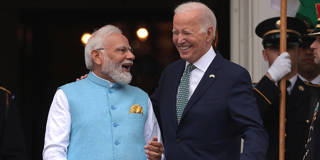With its new, unprecedentedly generous approach to India, the United States would appear to be giving away quite a lot in exchange for very little. Yet when considered from a long-term perspective, the American strategy makes sense for an increasingly multipolar world.
PROVIDENCE – The unprecedented lovefest between the United States and India has been striking and, frankly, puzzling. Following the pageantry of US President Joe Biden hosting a state dinner for Indian Prime Minister Narendra Modi, and of US Speaker of the House Kevin McCarthy inviting Modi to address a joint session of Congress for a second time, one wonders if America is giving away the store and getting very little in return.

PROVIDENCE – The unprecedented lovefest between the United States and India has been striking and, frankly, puzzling. Following the pageantry of US President Joe Biden hosting a state dinner for Indian Prime Minister Narendra Modi, and of US Speaker of the House Kevin McCarthy inviting Modi to address a joint session of Congress for a second time, one wonders if America is giving away the store and getting very little in return.